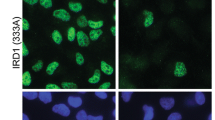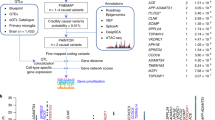Abstract
Human chromosome21 is the smallest and one of the most intensively studied autosomes. The generation of high quality genetic and physical maps for the long arm has enabled the research community to accelerate gene discovery and the identification of disease loci on the chromosome. However, the emerging pattern from large-scale transcriptional mapping from many groups suggests that the majority of the 600–1000genes predicted to reside on the chromosome are clustered in two distinct regions of the long arm, on distal 21q22.1 and 21q22.3. Here, we report the mapping of the gene for receptor interacting protein140 (RIP140) on 21q11 by means of YACs, PACs and hybrid cell lines. We have placed RIP140 within 100kb of D21S13, in a region of the chromosome where only one other gene has been described to date. The association of the RIP140 protein with the superfamily of nuclear receptors may be of significance in studies of trisomy21 (Down syndrome) and Alzheimers disease, since a modifier locus has been speculated to reside on 21q11.
Similar content being viewed by others
Author information
Authors and Affiliations
Additional information
Received: 12 August 1997 / Accepted: 10 October 1997
Rights and permissions
About this article
Cite this article
Katsanis, N., Ives, J., Groet, J. et al. Localisation of receptor interacting protein140 (RIP140) within 100kb of D21S13 on 21q11, a gene-poor region of the human genome. Hum Genet 102, 221–223 (1998). https://doi.org/10.1007/s004390050682
Issue Date:
DOI: https://doi.org/10.1007/s004390050682




